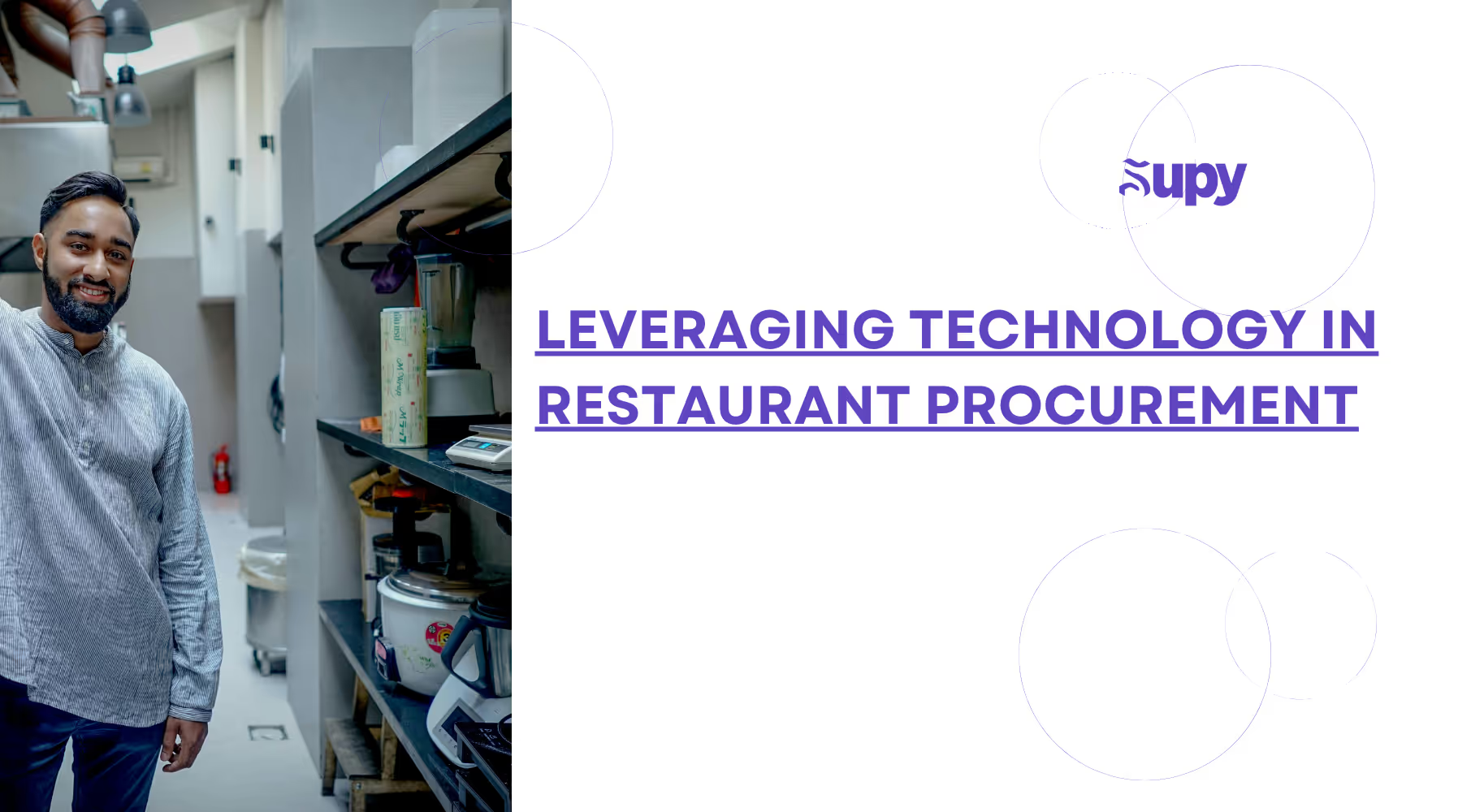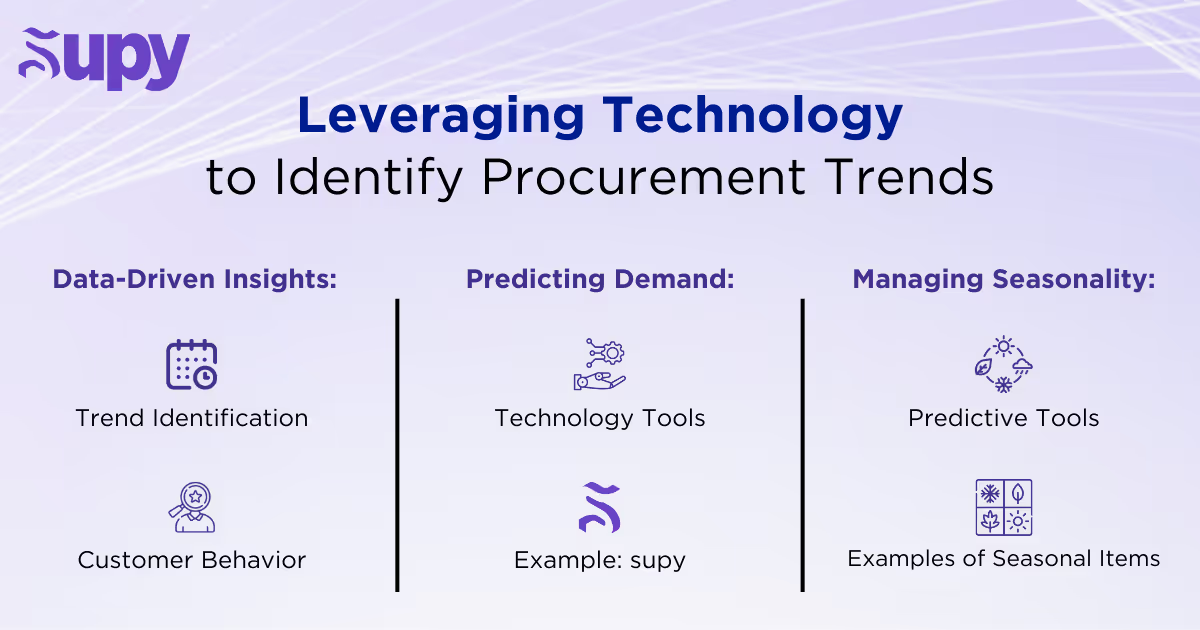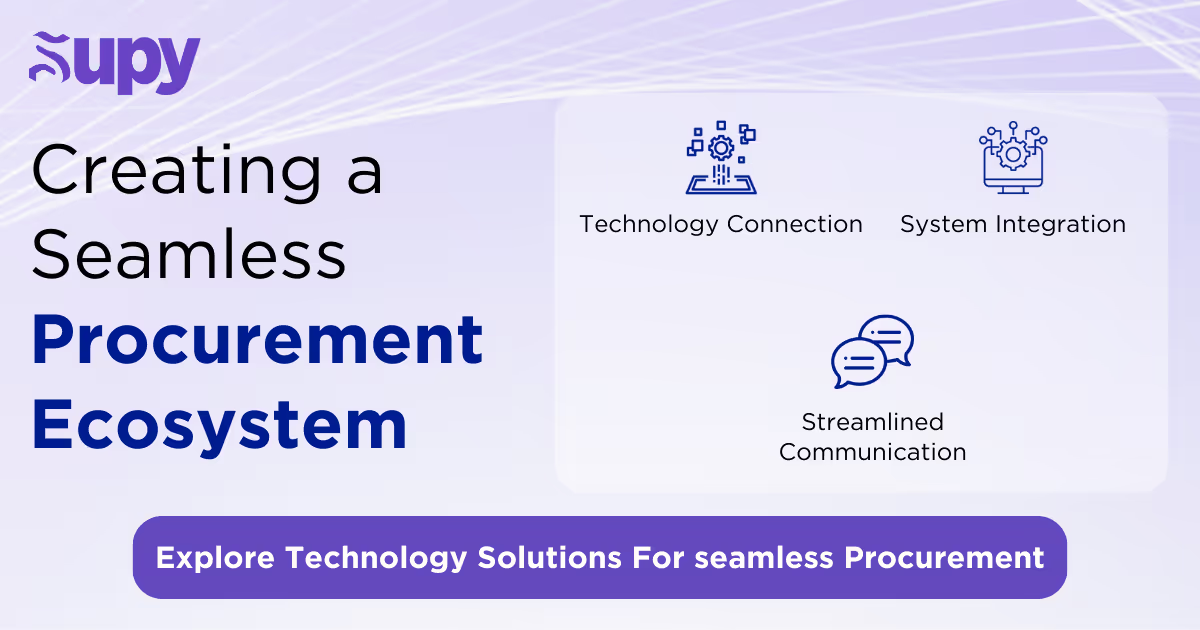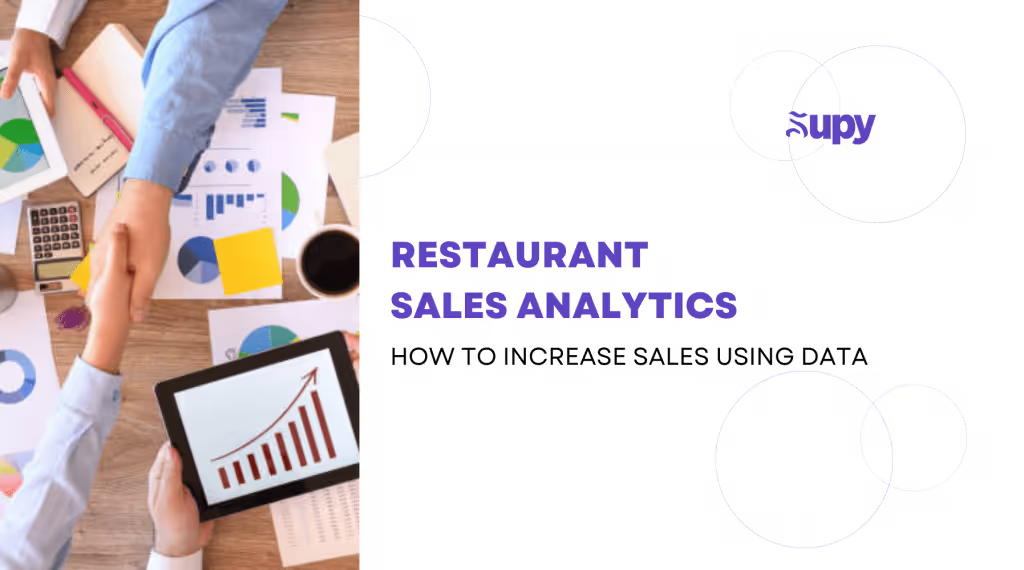Leveraging Technology in Restaurant Procurement

If you’ve worked in the food and beverage industry for any significant amount of time, you may have heard of how procurement plays a key role in maintaining smooth restaurant operations. Yet nobody said managing your procurement processes was going to be easy. Tasks such as tracking data at each level of your supply chain, anticipating different seasonal demands, and ensuring your inventory is accurate can all quickly become overwhelming if you don’t have the right tools in place.
This is where technology in procurement comes into play. By investing in different kinds of restaurant procurement technologies, restaurants can gain access to a variety of exciting new features, including automated data tracking, enhanced forecasting abilities, and access to real-time data insights. With the right tech features in place, restaurants can anticipate demand, minimize waste, and ensure smooth communication with their suppliers, all of which lead to improved operational efficiencies.
Table of Contents
- Understanding the Complexities of Modern Restaurant Procurement.
- The Importance of Data Tracking in Procurement and Why Manual Tracking Falls Short.
- How Technology Can Transform Restaurant Procurement.
- Using Procurement Technology to Identify the Latest Restaurant Trends.
- From Supplier to Restaurant to Customer: How to Create the Perfect Procurement Ecosystem.
- Managing Cost Savings and Supplier Relationships through Technology.
- The Future of Restaurant Procurement.
- Leveraging Restaurant Procurement with Supy.
- Conclusion.
- About Supy.
Enter Supy—a restaurant management platform designed specifically for people like you! Among its many features is the ability to streamline your entire procurement process—from sourcing to supplier management and product delivery! In an increasingly competitive restaurant landscape, embracing technology is no longer something most restaurants can avoid. To learn more about how Supy can help you manage your procurement processes, read on!
1. Understanding the Complexities of Modern Restaurant Procurement
Your “procurement ecosystem” is your company’s specific, highly interconnected business environment. Like any ecosystem, it comprises both internal and external elements. The stronger your ecosystem—and the more integrated the elements—the stronger your procurement performance will be.
In the restaurant industry, procurement is a complex ecosystem involving the coordination of multiple suppliers, inventory management, demand forecasting, and cost control. At its core, procurement ensures that a restaurant has the necessary ingredients, supplies, and equipment to operate efficiently. However, this process extends beyond merely ordering items; it involves building relationships with suppliers, negotiating pricing, managing logistics, and maintaining quality standards.
Sounds simple enough, but there are a few key challenges restaurants face during the procurement process:
First Challenge: Navigating Suppliers
One of the first challenges is figuring out how to deal with a vast network of suppliers. Restaurants often source their ingredients from multiple vendors, including local farmers, wholesale distributors, and international exporters. This can create inconsistencies in vendor performance and vendor management--including differences in pricing, quality, and delivery times.
Second Challenge: Demand Fluctuations
Additionally, fluctuations in demand can make it hard to accurately forecast your needs. Misjudging your customer demands can either result in either overstocking (leading to waste and increased costs) or understocking (causing shortages that negatively impact customer experience).
Third Challenge: Data Visibility Limitations
Finally, limited visibility into your data can make the procurement process difficult. Restaurants must not only monitor what they are buying but also how quickly their products are being consumed. Without access to real-time data, procurement managers will often struggle to track their inventory, manage supplier performance, and optimize purchasing decisions.
That’s why data-driven procurement systems have become an essential part of any healthy restaurant business. By integrating these new technologies, restaurants can automate their processes, streamline communication between suppliers, and access real-time data on stock levels and consumption trends.
2. The Importance of Data Tracking in Procurement and Why Manual Tracking Falls Short
As we have seen, when it comes to restaurant procurement, data plays a pivotal role in ensuring that your operations run smoothly. Yet relying on manual data tracking is inefficient, prone to errors, and severely limits a restaurant's ability to forecast demand. As your restaurant—and thus the volume of your data—grows, it can be more and more challenging to keep track of this information manually.
Whether through spreadsheets or paper logs, manual tracking is a process prone to human error. One mistake in data entry or overlooking one line item can result in disastrous inventory shortages or pricing discrepancies. When a restaurant is forced to rely on manual methods, critical metrics such as consumption rates, stock levels, and supplier timelines are often miscalculated, leading to delays in ordering and delivery.
Impact on Inventory, Supplier Relationships, and Costs
It’s no surprise that poor data management practices will have ripple effects across the entire procurement chain. Inaccurate inventory counts can lead to stockouts (which disrupt kitchen operations and lead to lost sales) or excess inventory (which results in waste and increased holding costs). Additionally, manual tracking can strain supplier relationships. When a restaurant fails to provide accurate forecasts, suppliers are unable to meet demand, which can lead to delayed deliveries or increased costs.
A real-world example of the above can be found in one restaurant that tried to source beef tenderloin from the USA. With no insight into their past consumption or any real-time data on stock levels, the restaurant was unable to accurately forecast its demand. Disastrously, this led to a 21-day beef tenderloin stockout! The restaurant’s poor data forecasting abilities damaged both its supply chain and its ability to serve customers. Luckily, once the restaurant successfully integrated Supy, its product consistency, and cost became much more consistent and defined.
How Technology Fills the Gaps
In a pre-COVID world, it was easier to forecast your demands based on a qualitative analysis of the market. Securing a 6-12 month stock supply was the norm, as inflation was at 2-3% and the economy was mostly stable. Yet the post-COVID market’s been shaken up from head to toe! With constant inflation, you’d be lucky to secure your stock for a month, much less 6! In today’s world, restaurants need to analyze their menus and check their bottom line if they are to make any attempt at accurately forecasting their needs. Such constant fluctuation has made procurement technology a necessity, not a luxury.
Integrated procurement tools like Supy provide real-time data tracking, automate inventory management, and generate accurate forecasts based on historical consumption patterns. By integrating tech solutions into procurement processes, restaurants can significantly improve efficiency, reduce waste, and foster better relationships with suppliers, ultimately improving overall profitability.
3. How Technology Can Transform Restaurant Procurement

For modern restaurants, technology in procurement has become a crucial way to maintain restaurant costs and product consistency. Here are some common specialized tech tools that can help you make data-driven decisions for your business:
- ERP (Enterprise Resource Planning) Systems: These integrate various functions of restaurant operations, offering real-time data into your stock levels, sales, and supply chain logistics. The centralization of the ERP system also helps you track inventory movement and understand trends in demand.
- Inventory Management Software: These allow for detailed tracking of ingredients, preventing stockouts and over-ordering.
- Supplier Management Platforms: These are designed to provide transparency on supplier performance, delivery times, and pricing to improve the entire procurement cycle.
The Role of Automation and AI
Lately, automation has begun to take on a key role in the restaurant procurement cycle, reducing the likelihood of human error and improving the accuracy of stock levels. With new AI-driven systems, restaurants can forecast demand by analyzing historical data. For instance, you could judge how much of a particular ingredient you may need to order based on upcoming sales data, thus optimizing orders and minimizing waste.
4. Using Procurement Technology to Identify the Latest Restaurant Trends

In restaurant procurement, it’s important to identify trends and patterns of consumption to maintain a consistent supply chain. By leveraging technology in the procurement process, you can gain clear insights into the ever-fluctuating nature of customer demand.
Data-Driven Insights for Trend Identification
Technology plays a crucial role in allowing restaurants to collect and analyze data on customer behavior and purchasing patterns. With digital procurement platforms, restaurants can identify historical trends in demand, which are often influenced by factors such as the weather, holidays, or even local events.
For instance, restaurants may notice that demand for seafood spikes during summer months, while comfort foods like stews become popular in the colder seasons. You may also notice that weekend traffic tends to be higher in most restaurants, thus requiring a larger inventory for items like beef or poultry, while weekdays may see a demand for lighter, quicker meals like sandwiches!
Managing Seasonality with Procurement Technology
Seasonal shifts are a major driver of supply chain complexity, and most procurement technologies will help you plan in advance by offering predictive tools. Digital platforms like Supy’s can help restaurants plan their seasonal items and adjust their procurement accordingly. Whether it's ordering more pumpkin-based dishes during fall or fresh berries in summer, such technology allows you to manage the flow of seasonal ingredients without overburdening your supply chain system.

5. From Supplier to Restaurant to Customer: How to Create the Perfect Procurement Ecosystem

Connecting the Dots with Technology
One of the biggest advantages of installing procurement technology is how it helps you synchronize your supply chain. By connecting various components such as the supplier, your inventory, and customer demand into a unified digital platform, restaurants can gain real-time insights into their stock levels, supplier performance, and demand forecasting.
Without the right restaurant inventory management software, managing the flow of goods—from supplier to restaurant, and ultimately to the customer—can be chaotic and prone to errors. Leveraging the right technology in the procurement process creates a seamless ecosystem where all stakeholders are connected in a smooth, data-driven workflow.
Streamlining Communication and Order Tracking
Installing the right kind of procurement technology can also streamline supplier management processes. Whether it’s placing an order, tracking shipments, or adjusting delivery schedules, procurement platforms provide a transparent system where both parties can manage their operations efficiently. With automated order tracking systems, restaurants can stay up to date on the latest status of their deliveries. This can allow restaurants to quickly identify delivery delays and adjust their menu accordingly to avoid service disruptions!
Integrating Procurement Tech with Other Restaurant Systems
Yet the true power of procurement technology lies in its ability to integrate with other restaurant management systems, including POS (Point of Sale) and kitchen management software. By integrating procurement data with the kitchen system, for example, you can make sure that items on the menu are always available. Meanwhile, POS integration can help you track sales trends to refine future forecasting processes.
6. Managing Cost Savings and Supplier Relationships through Technology
Improving Cost Control with Procurement Technology
One of the most significant advantages of technology in procurement is the ability to track and manage costs in real-time. A digital procurement system enables restaurants to monitor supplier prices, set budgets, and compare pricing across multiple vendors. This leads to a more informed restaurant purchasing process regarding where and when to buy ingredients, thus ensuring cost-effective sourcing.
Creating Enhanced Supplier Relationships with Procurement Technology
Beyond cost control, procurement technology strengthens supplier relationships. Traditionally, communication between restaurants and suppliers could be fragmented, leading to delays, misunderstandings, and missed opportunities for collaboration. However, with the help of digital tools, communication becomes seamless, and data transparency improves trust between both parties.
7. The Future of Restaurant Procurement
With so much to offer, the restaurant procurement landscape is constantly evolving. Here are some emerging technologies poised to redefine how the modern restaurant manages its supply chains:
Perhaps the most promising advancement would be in the area of blockchain technology. With blockchain, restaurants can track the journey of their ingredients from farm to table, ensuring quality control and ethical sourcing. This level of transparency not only builds trust with consumers but also helps prevent supply chain fraud and reduces inefficiencies, leading to improved procurement decisions.
Another potential game-changer is in the area of artificial intelligence (AI), particularly in predictive analytics. AI algorithms can analyze vast amounts of data—including past sales, market trends, and weather patterns—to forecast demand with remarkable accuracy. For instance, you could potentially use AI in the future to predict how a local event may affect your need to stock up on specific ingredients.
Lastly, the Internet of Things (IoT) is also making a significant impact on the procurement industry by enabling real-time inventory tracking. With smart sensors, restaurant owners can flag when supplies are running low or when food items are nearing their expiration dates. This reduces the risk of overstocking or stockouts, allowing for a more efficient, data-driven procurement process.
8. Leveraging Restaurant Procurement with Supy
Supy is designed to offer several comprehensive services that can help you in your journey toward streamlined multi-location restaurant management. Here’s how Supy can simplify the procurement process:
- Unlock Profitable Restaurant Procurement: Track the value of your purchases across your suppliers and restaurant locations. Coordinating with your suppliers through the latest restaurant technology is an excellent way to streamline your supply chain and prevent overstocking. This ensures sustainable practices like avoiding spoilage and excess inventory that can lead to wastage.
- Purchasing Ingredients Has Never Been Easier: One of the best parts of installing the Supy app is how it lets you centralize all your ingredients and suppliers under one roof! Now you can review your order totals, edit items, and approve drafted purchases on-the-go!
- Create Categorized Purchase Orders: Take the hassle out of ordering ingredients for your team by collecting items sourced by different suppliers under their own categories. If you find yourself regularly sourcing items from the same supplier, Supy will even let you set them as a preferred supplier to accelerate the purchasing process! How’s that for building a smoother supply chain?
- Order To Par & Never Over Or Understock on Items Again: In the Supy app, you can now set a par and minimum level for each item in your inventory. Set personalized alerts that notify you when items go below par and order the exact quantity of all items you need during your next procurement operation—all with a single click!
9. Conclusion
At the end of the day, there’s no doubt that by integrating technology into your restaurant procurement operations, you are making a wise investment in your restaurant’s operational success. After all, the challenges of managing vast amounts of data, forecasting demand, and ensuring supply chain consistency can overwhelm even the most seasoned procurement teams. By adopting advanced technological solutions, restaurants can streamline their supply chain from top to bottom, making the procurement process a breeze!
Curious to find out more? Sign up for Supy’s newsletter to learn more about the benefits of a tech-driven restaurant procurement process—or book a free demo today to experience your transformation firsthand! Alternatively, head on over to the Xenia app to learn more about the 10 best retail audit softwares in 2024!
10. About Supy
Supy is the best restaurant management software designed for multi-branch restaurants. With incredible features like real-time inventory tracking, smart procurement systems, and advanced analytics, Supy helps restaurants get the most out of their business. Whatever challenges you may face, Supy provides the tools you need to thrive in the dynamic restaurant industry.
For the latest expert insights, download Supy’s ebook: The Ultimate Guide to Reducing Food Costs in Multi-Branch & Enterprise Restaurants.
Ready to find out more? Schedule a demo with Supy today!







